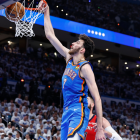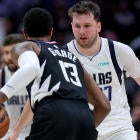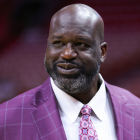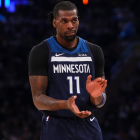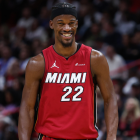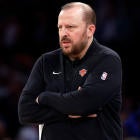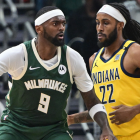LOS ANGELES -- When you jump over a car to win a dunk contest, when you become the NBA's funniest pitchman, it turns out that isn't what establishes you as one of the transcendent basketball talents on Earth.
Blake Griffin knows that now. Maybe he always knew it. But what the Clippers' forward is doing on the basketball court -- things few humans have ever done -- is making his star shine more brightly than Madison Avenue ever could.
Without props, cue cards, gimmicks or the slightest sense of humor, Griffin has taken over the NBA Playoffs -- "quietly" dominating the defending champion Spurs in the first round and ringing up another triple-double (26 points, 14 rebounds, 13 assists) in a 117-101 victory in Houston on Monday night to give the Clippers a 1-0 lead in the series, without Chris Paul.
The immense talent Griffin has become was not born in that corporately orchestrated dunk contest victory at Staples Center during 2011 All-Star weekend, nor out of his deadpan stare in those brilliantly funny Kia commercials.
The story is much more technical and complicated, and the prologue was written during the months after the Clippers lost to the Thunder in six games in the Western Conference Semifinals last spring. It was a mixture of hours spent reinventing his shooting stroke with Clippers shooting coach Bob Thate ... grueling conditioning workouts that pushed the envelope of science and technology ... and a series of heart-to-hearts with the Spurs' Tim Duncan about how to be a better leader and winner.
"He really respects Tim," said Griffin's Atlanta-based business manager, Lorne Clark. "His thing was, "How do I become more of a leader and how do I help this team win? What do I have to do?"
Duncan, a 39-year-old five-time champion, gave the Clippers all they could handle in the first round. Last summer, he gave Griffin, a 26-year-old, five-time All-Star, his blueprint -- only to watch Griffin ultimately embrace it at the Spurs' expense.
Produce, Duncan told him. Lead by example. Make people respect your actions. Have personal relationships with each of your teammates so you can have one-on-one conversations with them when they need you.
Griffin listened, and took notes. Then, during the idyllic summer months in LA, it was time to execute the plan.
The gym became Griffin's lab. Most days, when Clark texted him at 7 a.m. to find out his schedule, Griffin was already there -- either on the Clippers' practice court in Playa Vista with Thate, resetting his shooting mechanics, or at a private training facility in El Segundo with his trainer, Robbie Davis, who taught Griffin how much harder, and smarter, he could work.
"We want him to push himself really hard, be comfortable doing it and be able to recover really fast," Davis said.
All professional athletes push their limits, but Griffin wanted to know exactly where those limits were -- and how to specifically train to expand them and manipulate his performance.
After the loss to the Thunder, Griffin reported for duty at Davis' Gameshape Inc. training facility -- 17 miles from Staples Center, deep inside an angular, two-tone concrete warehouse surrounded by a mix of commercial and residential buildings. Griffin put on a breathing mask, strapped a heart-rate monitor around his chest and went to work.
Davis used the gadgets to do what is known as a metabolic assessment. Principally, he needed a baseline measurement of how Griffin's body used oxygen at maximal cardiovascular output -- and at what specific point oxygen consumption tailed off in response to training.
"It's the most efficient way of getting into basketball shape," Griffin said.
This figure, known as VO2 max, would dictate the type, intensity and length of Griffin's training bursts. The heart-rate monitor -- worn around his chest, like a high-tech belt -- would tell Davis when Griffin achieved his peak heart rate (for him, about 180 beats per minute), and more important, how long it would take Griffin's heartbeat to return to its resting rate after various bursts of activity.
"Basically what that data told me -- and if you watched the games, it made sense -- was that he was very good at really quick, explosive movements," Davis said. "Those things were very easy for him. So he was able to push his heart rate really high, really quickly and be very comfortable doing it.
"One of his weaknesses was how quickly he could recover from that," he said. "He could go really hard and be really comfortable doing it, but it would take him a little longer to catch his breath and recover."
Even with so much data available on NBA players' movements -- the league's SportVu technology captures every player's location on the floor 25 times per second -- Davis needed more. He tracked and timed Griffin's movements during games and found that the average, uninterrupted exertion time between dead balls was 2 minutes, 12 seconds. Most of the activity ranged between 40 seconds and a little more than a minute.
To the average person, this is techno-babble. To Davis, it's the Holy Grail. It means Griffin is performing most of the time in the first two of the body's three energy systems -- the ones fueled by stored energy in muscle tissue and a mixture of dietary and stored carbohydrate. So the demands on his body during an NBA game are mostly anaerobic -- short bursts of activity whose intensity outstrips the body's capacity to provide oxygen to fuel it.
"The data told us what he was burning and how he was using it," Davis said.
Davis, who left the Clippers in 2003 to start his own company, has trained Griffin for about five years; last summer was the first time he'd employed the heart-rate training method. During the offseason, they worked at his El Segundo facility. For in-season sessions, Griffin had a training center built in his home.
When Griffin missed 15 games during February and March after surgery to treat a staph infection in his right elbow, Davis' metabolic lab suffered a setback. For the first two weeks post-surgery, Griffin wasn't allowed to do anything that would make him sweat. When he and Davis picked things up again, they had to start over -- and the results illustrate how this training method has improved Griffin's ability to sustain energy during games.
When Griffin resumed training, it took 2 1/2 to 3 minutes for his heartbeat to return to its resting rate after maxing out at 180 beats per minute. After two weeks of training, Griffin's recovery time was down to 45-50 seconds.
"In a perfect world," Davis said, "we want him to get down to 30 seconds."
To achieve this, Davis ran Griffin through simulated games during which he was performing the same movements -- at the same intensities and time intervals -- he would experience in a real game. They started with a 12-minute quarter, with regulation timeouts, and quickly progressed to two-, three- and four-quarter simulations with halftime breaks.
"We'd warm up on the treadmill and then we'd go out to the court and do defensive slides, closing out, running full court, backpedaling," Griffin said. "And then maybe next time it would be offense -- sprinting into pick-and-rolls, rolling and getting a layup."
All the while, Griffin's monitor was transmitting to Davis' phone, so his trainer could see in real time when his heart rate reached its apex and how long it took to recover. Repeatedly training in and out of these specific cardiovascular zones caused Griffin's body to adapt to the stimulus, expanding his work capacity and reducing his recovery time.
And it made Davis' job easier, too. Any trainer can bark at his client to "keep pushing," but Davis actually knows when it's time to push and when it's time to back off.
"With my athletes, even if they tell me they're tired, I know," Davis said. "And I can say, 'I'm looking at your data right here, you have more in the tank. Let's go."
In watching the data, Davis said he was looking for "flexion points" in Griffin's heart rate that signal when he's no longer comfortable with the exertion level. The goal is to systematically push those flexion points farther and farther out, so Griffin can stay comfortable with longer bursts of activity and recover faster.
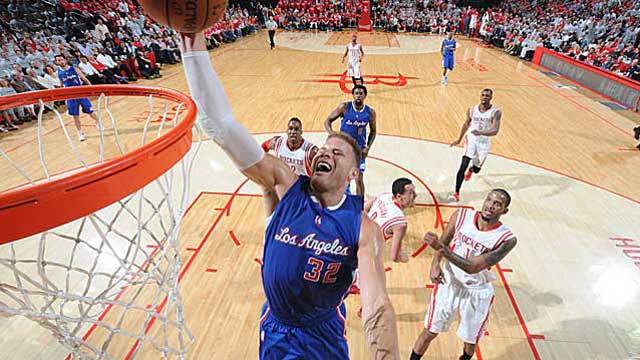
Apparently, it's working. Griffin's averages thus far this postseason of 24.4 points, 13.3 rebounds and 8.1 assists have been surpassed only ONCE in NBA history Ð by Oscar Robertson in 1962-63, according to Basketball-Reference.com. Since 1985, only Griffin, Kevin Garnett, LeBron James, Charles Barkley (twice) and Larry Bird have averaged at least 20 points, 10 rebounds and seven assists in a first-round series. Add Griffin's averages of 1.4 blocks and 1.4 steals, and the exclusive club shrinks to only two members -- Blake and Chuck.
"This is the healthiest I've been coming down the stretch of a season," Griffin said.
| Only behind 'The 'Big O' | ||||
| Only Oscar Robertson, in 1963, has averaged more than 24 points per game, 13 rebounds per game and 7 assists per game in a single postseason, but Blake Griffin has put up similar numbers in this year's playoffs. | ||||
| Player, Team (Year) | G | PPG | RPG | APG |
| Oscar Robertson, Royals (1963) | 12 | 31.8 | 13.0 | 9.0 |
| Blake Griffin, Clippers (2015) | 8 | 24.4 | 13.3 | 8.1 |
Of course, there are certain conditions no training regimen can simulate -- like playing 40-plus minutes per game against the indomitable Spurs after averaging 35 minutes during the regular season. There were times in the Spurs series when Griffin looked exhausted; everyone did. This was particularly the case in Game 5, which came after a 2 or 3 day bout with a sinus infection.
"It's hard to compare when you're playing 40-something minutes," Griffin said, "but yeah, I felt as good as possible down the stretch."
If this all seems too futuristic to be true, wait until you see where this technology is going in the very near future. Several companies already have developed wearable technology whereby athletes will be able to transmit biological data during games. So, when Griffin's recovery time dips below his normal range, someone on the bench will be able to tell Doc Rivers that it's time to sub him out.
Crazy idea? Not to NBA owners, who viewed a panel discussion on such wearable technology during the annual Technology Conference at All-Star weekend in New York in February.
"I don't think it's that crazy at this point," Davis said. "It's more a matter of getting the OK from the NBA to do something like that. You can do it in practices and scrimmages, but if we could do it in the game, you could get some pretty incredible data."
The data don't lie when it comes to the work Griffin did on his previously questionable shooting technique, either. Using information gathered from Synergy Sports Technology and other sources, Thate put Griffin through rigorous shooting drills that replicated the very spots on the floor where he gets his jump-shooting opportunities in the Clippers' offense.
Unlike SportVu, Thate's eyes don't work at 25-frames-per-second, but obviously, they're good enough. This season, Griffin attempted 38 percent of his field goals between 16 feet and the 3-point line, compared to 27 percent in 2013-14 -- and he made 40 percent, compared to 37 percent, according to Basketball-Reference.com.
"His goal coming into the league was to become a complete player," Clark said. "He doesn't want to be typecast as a one-dimensional guy."
Perceptions of Griffin as the Kia-jumping dunker and hilarious pitchman whose game was incomplete are finally beginning to fade -- not that Griffin has noticed. Maybe that's one more thing he learned from Duncan, that you should never let perception trump your reality.
"I've wanted that for so long, and over the past couple of years, I think I've kind of almost let that go a little bit," Griffin said. "I can't say I don't care as much, but I just realize what's important. I know people are going to say that no matter what. I'm just focused on me. I feel so much more relaxed, so much more comfortable with myself -- especially on the court -- that it doesn't really affect me anymore."
And that's no sales pitch. Judging from what he's doing to opponents, it's the truth.














